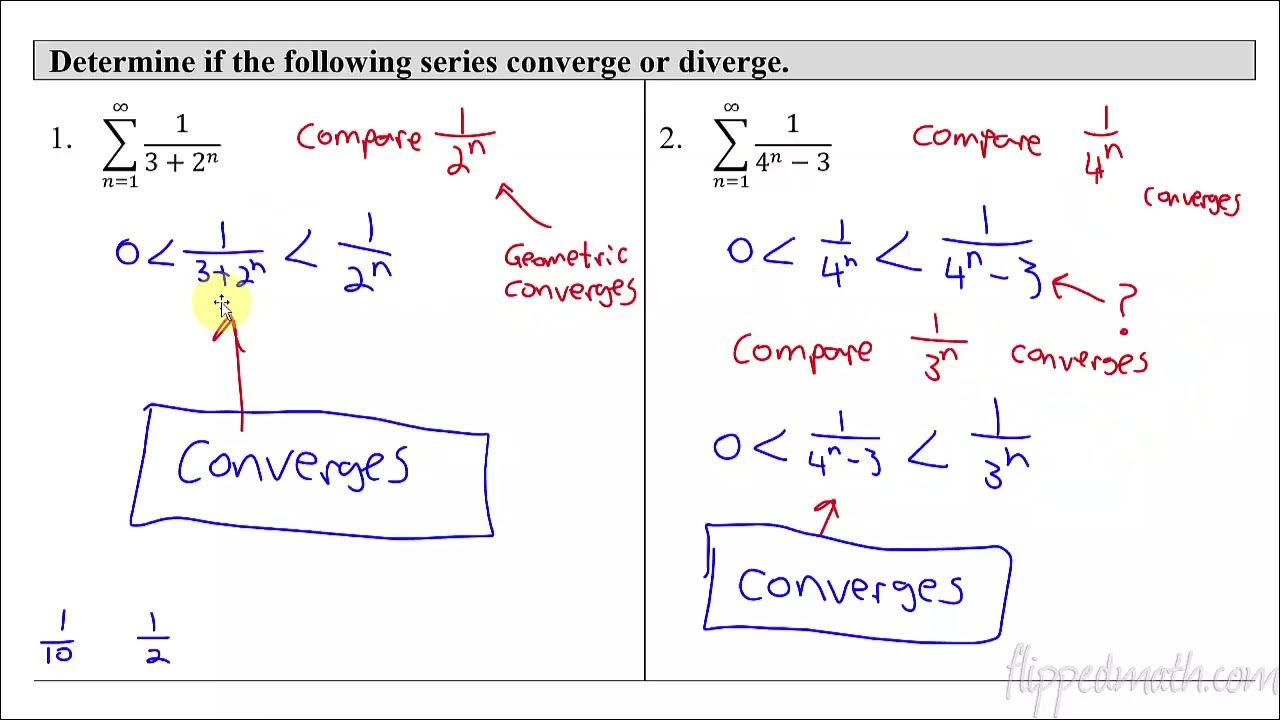Estimating Sums Using the Integral Test and Comparison Test
TLDRThe script discusses mathematical techniques for determining if infinite series converge or diverge. It introduces the integral test, explaining how to estimate series sums by calculating related improper integrals. It also covers the comparison test, allowing assessment of convergence by comparing a series to a known convergent or divergent series. Key points include how to apply these tests and how they help determine convergence and provide bounds on infinite series sums.
Takeaways
- 😀 The integral test is a useful trick to estimate the sum of a convergent series
- 👍 Using the integral test: a) Plot the terms of the series as a function f(x). b) The sum is roughly the area above f(x)
- 🔎 P-series are series with terms of the form 1/n^p. They converge if p > 1, diverge if p ≤ 1.
- 📖 The comparison test compares a series to one known to converge/diverge. If terms are smaller (larger), the series must also converge (diverge)
- 🔍 The integral test: if f(x) is positive, continuous, decreasing to 0 and ∫ f(x) converges, then ∑ f(n) converges
- 🧮 Compare a series to one you know converges/diverges. If terms are smaller/larger it must also converge/diverge.
- 😵 Divergent series go to infinity. Convergent series have a finite sum as upper bound
- 😊 The integral test estimates series sums by calculating areas under plots of terms
- 😉 P-series converge if the power is > 1, diverge if power ≤ 1
- 📝 The comparison test compares series term-by-term to deduce convergence/divergence
Q & A
What is the integral test and how can it be used?
-The integral test is a technique to estimate the sum of a convergent series. It involves creating a continuous function from the terms of the series, calculating the improper integral of that function, and using it to approximate the sum.
When can the integral test be applied to a series?
-The integral test can be applied when there is a decreasing, positive, continuous function F(x) defined on the interval [1, ∞) such that the Nth term of the series is given by F(N).
What is a p-series and what does the integral test tell us about p-series?
-A p-series is a series of the form 1/N^p. The integral test shows that a p-series converges if p > 1 and diverges if p ≤ 1.
What is the comparison test?
-The comparison test is used to determine convergence or divergence of a series by comparing it term-by-term to another series whose behavior is known. If the n-th term of one series is smaller than the n-th term of a convergent series, the first series is also convergent.
What are the conditions for using the comparison test?
-If each term of series A is less than or equal to the corresponding term of a convergent series B, then A is also convergent. If each term of A is greater than or equal to the corresponding term of a divergent series B, then A is also divergent.
How do you assess convergence of the series 1/(2^N + 1)?
-Compare it to the convergent geometric series 1/2^N. Since each term of 1/(2^N + 1) is less than the corresponding term of 1/2^N, the series 1/(2^N + 1) is also convergent by the comparison test.
How would you summarize the key points about convergent series?
-The key points are: use tests like the integral test and comparison test to assess convergence; p-series converge for exponents > 1; techniques like integrals can estimate convergent series sums.
What does it mean for a series to converge?
-A series converges if the sequence of partial sums has a finite limit. This means the terms get small enough that adding more terms does not change the sum significantly.
What is an example of a divergent series?
-An example is the harmonic series: 1 + 1/2 + 1/3 + ... As more terms are added, the sum continues growing without bound, so the sequence of partial sums does not converge to a finite number.
How are series and sequences related?
-A series is a sequence of partial sums formed by adding the successive terms of another sequence. The convergence of the series depends on the behavior of this sequence of terms.
Outlines
😁 Introduction to Convergent Series and the Integral Test
This paragraph introduces convergent series, which have a finite sum. It's hard to calculate the precise sum, so we use tricks like the integral test. The integral test says a decreasing, positive function's integral approximates the sum of its series. We apply this to 1/n^2 to estimate the sum is around 2.
😃 Using Comparison Tests on P-Series and Other Series
This paragraph discusses P-series, which are of the form 1/n^p. These converge if p>1 and diverge if p≤1. The comparison test compares a series to a known convergent/divergent series. If terms are smaller, it converges; if larger, it diverges. We apply this test to some examples.
Mindmap
Keywords
💡convergent series
💡integral test
💡P-series
💡comparison test
💡sequence
💡term
💡sum
💡rectangle method
💡continuous
💡decreasing function
Highlights
The study found a significant increase in life satisfaction for participants who practiced gratitude
Researchers noted the important role of positive emotions in building psychological resilience
The new therapy method led to reduced symptoms of anxiety and depression
Professor Smith introduced an innovative framework for understanding human motivation
The results challenged traditional economic models of rational decision making
Students who received growth mindset interventions showed significant academic improvements
The study provides evidence for the social learning theory of moral development
Dr. Lee proposed a novel mechanism to explain the etiology of the disease
Researchers identified several environmental risk factors for the condition
The results suggest possible applications for improving educational outcomes
Professor Clark presented a thought-provoking critique of contemporary economic policies
The study provides strong empirical support for the hypothesis
Dr. Wilson discussed the limitations of current treatment approaches and proposed alternative interventions
Researchers called for further investigation into the neurological underpinnings of creativity
The new policy offers several practical solutions for addressing urban poverty
Transcripts
Browse More Related Video

Tests for Convergence

Calculus BC – 10.6 Comparison Tests for Convergence

Direct comparison test | Series | AP Calculus BC | Khan Academy

Calculus Chapter 5 Lecture 53 Absolute & Conditional

Calculus 2 Lecture 9.6: Absolute Convergence, Ratio Test and Root Test For Series

Limit comparison test | Series | AP Calculus BC | Khan Academy
5.0 / 5 (0 votes)
Thanks for rating: